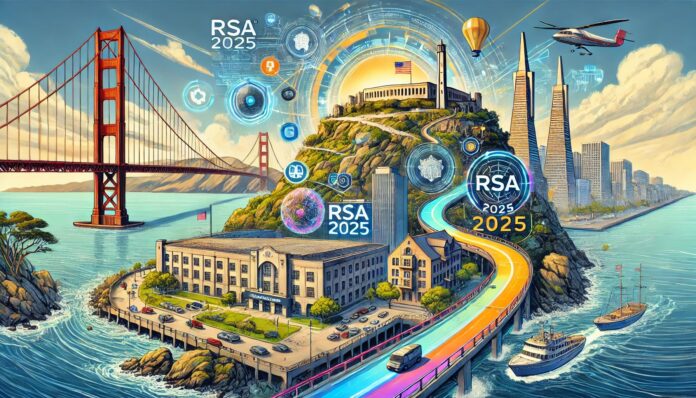
During the winter months, the fog hangs heavy over San Francisco, mirroring the shroud of uncertainty that often accompanies discussions around cybersecurity. As I prepare to attend RSA 2025, the city’s iconic backdrop, Alcatraz, casts a long shadow, offering an unexpected yet profound lens through which to view the evolving landscape of digital security.
Alcatraz, the infamous “Rock,” stands as a testament to a bygone era of security – one built on isolation, suspicion, and the absolute denial of trust. Inmates deemed the most dangerous criminals of their time, were incarcerated within its formidable walls, cut off from the outside world, and subjected to rigorous surveillance. This extreme model of security, while effective in its own context, is a stark contrast to the contemporary cybersecurity paradigm, where the emphasis has shifted towards enabling secure and efficient operations within a dynamic and interconnected world.
Zero Trust, the dominant security framework of our time, embodies this shift. At its core lies the fundamental principle of “never trust, always verify.” This paradigm rejects the traditional network perimeter model, where trust is implicitly granted to entities within the network boundary. Instead, it mandates that every user, device, and application, regardless of location, must be rigorously authenticated and authorized before accessing any resource.
The parallels between Zero Trust and Alcatraz, while seemingly disparate, run deeper than initial impressions might suggest. Both, in their own ways, embody a philosophy of strict control and meticulous verification. Alcatraz, with its impenetrable walls, armed guards, and constant surveillance, mirrored the layered security approach advocated by Zero Trust. Multiple layers of defense, from physical barriers to intricate security protocols, were designed to thwart any potential escape attempts.
Similarly, Zero Trust emphasizes a multi-layered approach to security, incorporating technologies like:
- Identity and Access Management (IAM): Rigorous authentication and authorization mechanisms, including multi-factor authentication, biometrics, and continuous risk-based authentication, ensure that only authorized entities can access sensitive data and systems.
- Data Loss Prevention (DLP): Technologies that monitor and control the movement of sensitive data across the network, preventing unauthorized access and data breaches.
- Endpoint Security: Robust security measures are implemented on endpoints such as laptops, desktops, and mobile devices, including antivirus, anti-malware, and intrusion detection systems.
- Network Segmentation: Dividing the network into smaller, more secure segments to limit the impact of potential breaches.
- Cloud Security: Implementing security controls within cloud environments, including infrastructure as code (IaC), encryption, and access controls.
- Security Information and Event Management (SIEM): Centralized logging and analysis of security events across the organization, enabling proactive threat detection and response.
Beyond these technical measures, Zero Trust also emphasizes the importance of:
- Continuous monitoring and threat intelligence: Proactively identifying and responding to emerging threats through continuous monitoring, threat intelligence feeds, and security assessments.
- Data classification and labeling: Classifying data based on sensitivity and implementing appropriate security controls accordingly.
- Security awareness training: Educating employees about security best practices, such as phishing awareness and password hygiene.
However, the parallels between Alcatraz and Zero Trust also highlight a critical distinction: the ultimate goal. Alcatraz, with its focus on containment and punishment, prioritized security above all else. In contrast, modern cybersecurity frameworks, while prioritizing security, must also prioritize user experience, productivity, and business agility.
This distinction underscores the evolving nature of security. While the need for robust defenses remains paramount, the rigid, prison-like approach of the past is no longer tenable in today’s dynamic and interconnected world. Businesses must strive to create secure environments that enable innovation, collaboration, and seamless business operations.
As I walk the floor of RSA 2025, I will be keenly observing how vendors are addressing this evolving landscape. Are they focusing on user experience and ease of implementation? Are they providing solutions that address real-world challenges, such as the rise of hybrid work and the increasing complexity of the threat landscape? Are they helping organizations build a culture of security that empowers employees and fosters a sense of trust within the digital realm?
The challenge lies in striking a delicate balance between security and freedom, between control and empowerment. We must move beyond the rigid, fortress-like mentality of Alcatraz and embrace a more nuanced approach to security, one that enables innovation, collaboration, and a thriving digital ecosystem.
RSA 2025 provides a crucial platform for industry leaders, security professionals, and innovators to share insights, discuss best practices, and collectively address the evolving cybersecurity challenges of our time. As we navigate this complex landscape, let us strive to build a future where security not only protects but also empowers, where trust, though earned, can flourish.
This journey, from the stark isolation of Alcatraz to the dynamic, interconnected world of Zero Trust, reflects the evolution of our understanding of security. It serves as a reminder that true security lies not in rigid confinement but in a balanced approach that prioritizes both protection and freedom.




















